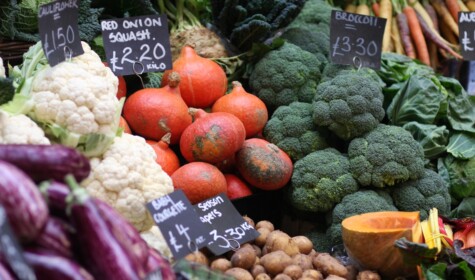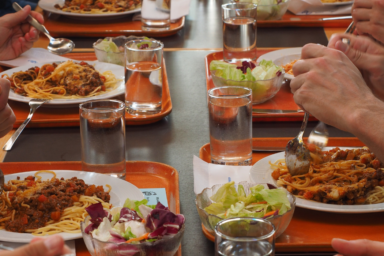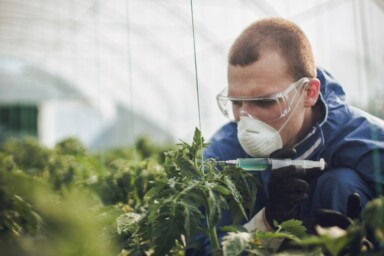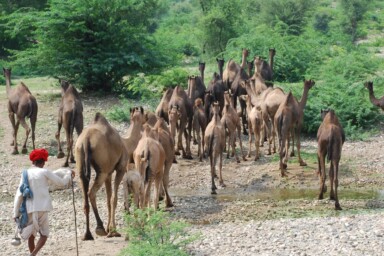The Sustainable Food Trust’s Isabel Eaton explores how changing our diets could enable the UK to eat more healthily while farming more sustainably.
The foods we eat impact our energy levels, mental wellbeing, risk of disease and overall quality of life. Yet, at this year’s Oxford Real Farming Conference, GP Sally Bell was one of several speakers to note a societal disconnect between health and food, with the way we currently eat as a nation damaging both our own wellbeing and that of the planet. Ultra-processed foods with low nutritional value, intensively raised livestock fed on rainforest-depleting soy and sustained by antibiotics, grains grown as monocultures in degraded soils and vegetables produced with chemical pesticides and fertilisers, are just some of the issues upsetting the balance of our bodies and ecosystems.
The depth of the problem is illustrated by the stark figures on diet-related illness in the UK. Government statistics show that over 60% of the population is now considered overweight or obese, with the highest rates of obesity in children found amongst those from deprived backgrounds, typically with the least access to nutritious foods. Whilst in 2021, Diabetes UK reported that cases of diabetes have doubled over the past 15 years, reaching an all-time high of 4.9 million people living with the condition. Combine these figures with a rise in malnutrition and other diet-related medical concerns across the nation and we appear to be at a point of crisis.
Eating to be healthy and sustainable
Change is clearly needed but the wide range of conflicting advice on what to eat for the good of our bodies and the environment has left many feeling deeply uncertain about how to eat in a way that is both healthy and sustainable. This is an issue that the Sustainable Food Trust’s latest report, Feeding Britain from the Ground Up, seeks to address by modelling a UK-wide transition to agroecological farming systems designed to work in harmony with nature and produce foods integral to a healthy diet. The report found that through significant changes to what we grow and eat, a nationwide transition to regenerative farming systems could maintain current levels of UK self-sufficiency and help to tackle the climate, nature and public health crises. So, what might our diets look like if we aligned what we eat with what the UK can sustainably produce?
Recognised by the UN for their positive contribution to food security, nutrition, health, climate change and biodiversity, pulses are a brilliant example of a crop that benefits both humans and nature. In our diets, pulses provide protein, fibre, vitamins and amino acids and have the potential to lower the risk of bowel cancer, heart disease, type-2 diabetes and stroke. On the land, they form a key part of sustainable crop rotations, requiring relatively little water to break pest and weed cycles, fix nitrogen in soil and create fertile ground for the crops that follow them. In recognition of these dual benefits for our bodies and the land, the production of peas and beans in the UK is doubled under the report’s modelling, with the availability of UK-grown pulses increasing from 7 to 35 grams per person per day.
The production of fruit and vegetables is also doubled in the report. The importance of including a wide variety of vitamin-, mineral- and fibre-filled fruits and vegetables in our diets is well known and the benefits for nature are also widely recognised, providing vital nectar sources for pollinators as well as bird- and insect-friendly habitats in the form of orchards and as part of agroforestry systems. Traditional orchards are considered so important for biodiversity that they have been designated a priority habitat by the People’s Trust for endangered species, but in spite of the clear benefits and a climate well suited to growing a broad variety of both, at present we produce just 50% of the vegetables and 15% of the fruits that we consume in the UK.
The increased production modelled in the report would equate to approximately 3.5 portions of UK-grown fruit and vegetables per person per day, although, workforce permitting, numerous studies have shown that production could be increased further in urban areas. Urban growing spaces, which include commercial operations, allotments and gardens, have the potential to not only boost production but also close the gap, both literally in terms of food miles and socially between inner-city communities and the food they eat, providing important educational opportunities, connecting people with the story of their food and heightening awareness of health and sustainability issues.
To enable such significant expansion in the production of fruits, vegetables and pulses, the amount of land dedicated to producing other foods, which may be less beneficial to health or less compatible with agroecological farming systems, would need to decrease. The quantity of grains, oilseed rape and sugar beet grown in the UK would fall by 50%, 70% and 80% respectively, reflecting in part the reduced yields associated with growing these crops without the use of chemical fertilisers and pesticides. The reductions are also due to the need to cut down sugar in our diets and limit soil erosion (in the case of sugar beet), and the significant drop in demand for grain that would result from the report’s modelled elimination of intensive livestock farming.
Half of the grains we currently grow in the UK are fed to livestock, therefore, despite the 50% reduction in production, the amount of cereals available for human diets would alter very little. The types of grains grown would, however, change. Wheat and barley currently dominate cereal production in the UK, with vast fields of monocultures bred and grown for yield and consistency rather than nutrition and flavour. Producing and consuming a wider variety of cereals suited to low input systems, including landrace grains, oats and barley, may benefit the environment and our diets as well as strengthening food security by increasing adaptability and reducing vulnerability to disease and unfavourable weather conditions. There are already some inspiring examples of this approach in action, including the work of Hodmedod’s, a UK-based supplier supporting British farmers to produce lesser-known varieties of grains and pulses in accordance with agroecological farming methods, as well as the Llafur Ni grains network in Wales which is helping farmers, including the Sustainable Food Trust’s CEO, Patrick Holden, to grow rare black oats.
The value of diversity
Genetic variety is just as important in livestock and of considerable concern given that in 2020, 80% of the UK’s native breeds were found to be at risk of extinction. Hardy native livestock are often well-suited to low-input agroecological farming but overlooked in intensive systems where more productive commercial breeds are favoured despite potentially providing less nutritional value and flavour, requiring large amounts of grain and soya-based feeds to maintain condition and being less well adapted to the UK climate. By widening the variety of sustainably farmed cattle, sheep, pig and chicken breeds that we produce, we could again strengthen food security, benefit the environment and enrich our diets.
In the regenerative systems modelled by the report, animal agriculture would be de-intensified, with a focus on welfare, elimination of imported feeds, reduction of waste and a move to pasture-based systems. These changes would have little impact on the amount of nutrient-dense lamb and beef available in our diets, as grazing livestock play a vital role in regenerative mixed farming systems. Dairy yields, however, would decrease by 20% (equating to a daily availability of just under two glasses of milk per person) and the production of chicken and pork would decline significantly from 50 to 13 grams (approximately one chicken breast per fortnight) and 24 to six grams (two to three rashers of streaky bacon per week), per day respectively. The availability of eggs would also drop from approximately three to four eggs per week per person to two. These reductions would constitute significant dietary changes for many but eliminating intensive livestock farming and reducing the amount of animal products in our diets, has a huge role to play in tackling climate change.
The way forward
Of course, even if the UK makes a transition to agroecological farming systems that protect the environment and widen the availability of local, seasonal, healthy produce, the cost of these foods would remain a barrier for many. The current cost of living crisis saw 18% of all UK households facing food insecurity in September last year and food inflation had reached 13.3% by December. Access to wholesome, sustainably produced foods is becoming ever more restricted and the threat to human and environmental health ever higher as a result. As detailed in the Feeding Britain report, a transition to agroecological farming systems won’t be possible without significant support from the government, financial institutions, retailers and the public and would represent a very significant shift in how we farm and eat. However, if it has the potential to improve the health of both humans and the environment and tackle the crises that both currently face, surely it’s a shift worth making?







